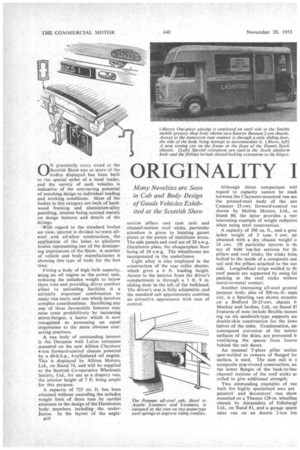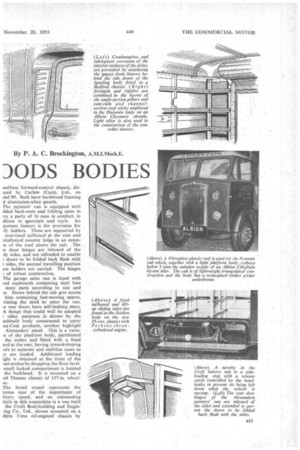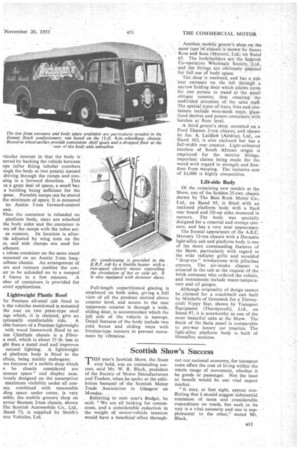ORIGINALITY I JODS BODIES
Page 44

Page 45

Page 46

Page 47

If you've noticed an error in this article please click here to report it so we can fix it.
By P. A. C. Brockington, A.M.I.Mech.E.
ON practically every stand at the Scottish Show one or more of the bodies displayed has been built to the special order of a local trader, and the variety of such vehicles is indicative of the cost-saving potential of matching design to individual loading and working conditions. Most of the bodies in this category are built of hardwood framing and aluminium-alloy panelling, interest being centred mainly on design features and details of the
fittings. .
With regard to the standard bodies on view, interest is divided be!,ween allsteel and all-alloy construction, the application of the latter to platform bodies representing one of the dominating impressions of the Show. A number of vehicle and body manufacturers is showing this type of body for the first time.
Fitting a body of high bulk capacity, using an oil engine as tha power unit, reducing the unladen weight to below three tons and providing driver comfort allied to unloading facilities is a critically important combination to many van users, and one which involves complex considerations. Sacrificing any one . of these .favourable features may raise costs prohibitively by increasing driver-fatigue, a factor which is now recognized as possessing an equal importance to the more obvious costsaving practices.
A van body of outstanding interest is the, Duramin with Luton extension mounted on the new Albion Claymore 4-ton forward-control chassis powered by a 60-h.h.p., 4-cylindered oil engine. This is displayed by Albion Motors, Ltd., on Stand 74, and will be supplied to the Scottish Co-operative Wholesale Society, Ltd., for use as a drapery van, ' the interior height of 7 ft. being ample for this purpose.
A capacity of 725 Cu. ft. has been obtained without exceeding the unladen weight limit of three tons by careful attention to the design of the Duralumin body members including the underframe. In the layout of the angle B i 0 section pillars and cant rails and channel-section roof sticks, particular attention is given to locating gusset plates at the points of maximum stress. The side panels and roof are of 20 s.w.g. Duralumin plate, the chequerplate floor being of 10 s.w.g. The wheelboxes are incorporated in the underframe.
Light alloy is also employed in the construction of the rear roller shutter, which gives a 6 ft. loading height. Access to the interior from the driver's compartment is through a 1 ft. 9 in. sliding door in the left of the bulkhead. The driver's seat is fully adjustable, and the standard cab appointments combine an attractive appearance with case of control. Although direct comparison witl regard to capacity cannot be mach between the Claymore-mounted van am the pressed-steel • body of the nev Commer 25-cwt. forward-control vat shown by Melvin Motors, Ltd., cn Stand 80, the latter provides a ver! interesting example of weight reductiot when using steel construction.
A capacity of 300 Cu. ft., and a gros laden weight of 3 tons 5 cwt. an obtained with a dry chassis weight' o 24 cwt. Of particular interest is tip use of wide top-hat sections for thi pillars and roof sticks, the sticks beiru bolted to the inside of a composite can rail and the pillars attached to the out side. Longitudinal strips welded to th, roof panels are supported by using fel packing at the roof sticks withou metal-to-metal contact.
Another interesting all-steel general purpose body, also of 300-cu.-ft. capa city, is a Spurling van shown mountei on a Bedford 20-25-cwt, chassis b: Mackay and Jardine, Ltd., on Stand 85 Features of note include flexible mount ing on six sandwich-type supports an' double-skin construction for the lowe halves of the sides. Condensation, an' consequent corrosion of the 'Mena surfaces of the skins, are prevented b. ventilating the spaces from louvre behind the cab doors.
An unusual T-piece pillar sectior spot-welded to runners of flanged bo section, is used. The cant rail is composite pop-riveted construction, an the lower flanges of the back-to-bac channel sections of the roof sticks ar rolled to give additional strength.
Two outstanding examples of van built for highly specialized uses are painters' and decorators' van show mounted on a Thames 128-in. wheelbas chassis by Alexanders of Edinburgl Ltd., on Stand 81, and a garage sparei sales van on an Austin 2-ton Ion reelbase forward-control chassis, distyed by Carlaw (Cars), Ltd„ on tnd 89. Both have hardwood framing d aluminium-alloy panels.
The pq.inters' van is equipped with dded back-rests and folding seats to rry a party of 16 men in comfort, in dition to riaterials and tools. An portant feature is the provision for -ft. ladders. These, are supported by iron-lined tailboard at the rear and reinforced counter ledge in an exten m of the roof above the cab. The . is door hinges are inboard of the dy sides, and are .eklended to enable doors to be folded back flush with sides, the normal travelling position ien ladders are carried. The hinges ; of robust construction.
The garage sales van is lined with od cupboards containing steel bins store parts according to size and )e. Doors behind the cab give access bins containing fast-moving spares, viating the need 'to enter the van. le rear doors have self-locking stays. A design that could well be adopted r other purposes is shown by the achbuilt -body constructed to carry Ica-Cola products, another highlight Alexanders' stand. This is a varia
n of the platform body, partitioned the centre and :fitted with a fixed ard at the rear, having inward-sloping ors to separate and stabilize cases as :ry are loaded. Additional loading ight is obtained at the front of the Leel-arches by dropping the floor level. small locked compartment is located the bulkhead. It is mounted on a ■ rd Thames chassis of 157-in. wheelse.
The bread round represents the treme case of the importance of Livery. speed, and an outstanding hircle in &di connection is a van built the Croft Bodybuilding and Engining. Co., Ltd., shown mounted on a ddon 3-ton oil-engined chassis by
Moodte and Co., on Stand 105. Standard trays are loaded lengthwise on the near side and both lengthwise and endwise at the rear in separate racks, a tubular framework being used to support the rack assemblies. A novel feature of the side-loading arrangement is the use of a step with a release catch controlled by the handbrake to prevent it being left down when the vehicle is in motion.
Lengthwise loading of bread trays, and endwise loading of closely spaced cake trays, are features of the baker's van built by the Scottish Co-operative Wholesale Society, Ltd., and shown mounted on a Karrier Bantam 2-ton chassis by T. M. Erskine arid Co., on Stand 92.
' This vehicle could also be used as a mobile shop, two sliding doors giving access to a free floor space forward of the racks behind the driver's seat. A set ot small trays on the left of the driver is used for fancy cakes. The rear of the vehicle is enclosed by roller shutter doors.
Exceptional Cab Refinements A distinctive frontal appearance, a luxury cab. with " all-round" vision, and an 18-ft. platform body of light alloy are features of the E.R.F. 8-ton brewery vehicle shown by James Bowen and Sons, Ltd., on Stand 87. The originality of the oval grille with small dummy air intakes on the sides is enhanced by large designs showing a laughing cavalier with a glass of ale. The E.R.F.-Jennings wood-framed cab has curved windscreens of Triplex toughened glass with a narrow centre strip providing rounded corner lights without quarter pillars. The interior is air-conditioned by a Smiths heater, with a two-speed electric motor controlling the circulation of cold or hot air. It is fitted with demister ducts. The cab is flexibly mounted at four points.
The body shown on the stand was supplied by Jennings of Sandbach. A light-alloy HomalIoy body is fitted to a similar vehicle in the demonstration park. Other details common to both vehicles are a detachable front panel which gives access to the radiator and rear of the instrument panel and facilitates removal of the engine from the front, a central towing jaw at the front, a facia board covered in leathercloi which matches the seats, a satin-finishc instrument panel and engine cove large toolboxes under the .seats, and Wilmot-Breeden push-button doorloc mechanism with a rotary lock. TI design of the chassis obviates the u: of pedestals and longitudinal runne for supporting the body.
Also displayed on the Bowen star is a Guy Otter 5-6-ton forward-contr. chassis of I4-ft. 9-in, wheelbase with standard all-metal cab and Homan( light-alloy platform body. The lengi of the body is 17 ft. 6 in. and its weigl below 10 cwt. The cab provides a no able example of a straightforwai design with a pleasing appearance ar good visibility.
Lightweight Platform Body Advanced cab design. underfim location of the oil engine, and a ligh alloy body with alloy rear win; designed by the vehicle makers, a characteristics of the Dennis Stork ton platform vehicle shown by ti Central Motor Co., on Stand Ill, whit together represent a high standard I practical originality in the mediun weight class of vehicle. The unladt weight of the truck is 2 tons 4 cw the body weighing 4 Cwt. 70 [b. TI extruded light-alloy sections wei evolved by the Dennis company.
Body fittings include a low tailboai with slotted locking extensions of .t1 hinges. A feature similacto that four on some of the other Dennis vehicli at the Show is a front bumper wil apertures giving access to towir hooks. The full-fronted Stork cab pr 'sides ample seating width for thn with extended leg room and a flo■ height of 1 ft. Sin.
The low front entrance floor of if Stork is seen to particular advantage e a confectionery van mounted on an 11-i 8-in.-wheelbase chassis displayed 1 Dennis Bros.. Ltd., on Stand 99. A cor partrnent separated from the van interii by sliding doors is used for stormi louse trays, bags and bottles of sweei the boxed-in, wheel-arches providir convenient shelf space. A dropped flui at the rear of the vehicle facilitates u loading. The body is constructed hardwood framing and light-alh panelling, and the vehicle has t unladen weight of 2 tons 19 cwt.
Although similar in conception to tl ramp-removed cattle body they pr duced for many years, the " ba loader" container shown by A. Penman, Ltd., on Stand 96, is
rticular interest in that the body is moved by backing the vehicle between nps (after fitting tubular members ough the body at two points) instead driving through the ramps and conning in a forward direction. This es a great deal of space, a small bay a building being sufficient for the -pose. Portable ramps can be stored the minimum of space. It is mounted an Austin 5-ton forward-control issis.
When the container is reloaded on platform body, stays are attached the body sides and the container is wn off the ramps with the tubes actas runners, Its location is afterrds adjusted by wing nuts on the 'Ps, and side clamps are used for ichment.
k. refuse container on the same stand mounted on an Austin 2-ton longeelbase chassis. An arrangement of ers and runners enables the conter to be unloaded on to a ramped :1 frame in a few minutes. A aber of containers is provided for erent applications.
Lightweight Plastic Roof
'he Penman all-steel cab fitted to h the vehicles mentioned is mounted the rear on two pram-type steel rigs which, it is claimed, give an eptionally comfortable ride. A able feature of a Penman lightweight with wood framework fitted to an ion Chieftain chassis is a Fibres roof, which is about 15 lb. less in ght than a metal roof and improves natural lighting. A lightweight )1:1 platform body is fitted to the reftain, being mainly mahogany.
wo features of a mobile shop which a be closely considered are stomer space" and display area. iously designed on the assumption maximum visibility under all conans, combined with reasonable ding space under cover, is very rable, the mobile grocery shop on arrier Bantam 2=ton chassis, shown The Scottish Automobile Co., Ltd., Stand 73, is supplied by Smith's :tric Vehicles, 'Ltd. Full-length unpartitioned glazing is employed on both sides, giving a full view of all the produce carried above counter level, and access to the rear transverse counter is through a wide, sliding door, to accommodate which the left side of the vehicle is inswept. Detail features of the body include two cold boxes and sliding trays with friction-type runners to prevent movement by vibration. . Another mobile grocer's shop on the same type 'Of chassis is shown by James Ross and Sons (Motors), Ltd., on Stand 65. The bodybuilders are the ScOttish Co-operative Wholesale Society, 'Ltd., and the fittings are obviously planned for full use of body space.
The shop is enclosed, and has a side 'rear entrance on the [eft through a narrow folding door which allows room for one person to stand at the small oblique counter, thus ensuring the undivided attention of the sales staff. The special types of trays, bins and cOntainers include wire-mesh trays, glasslined shelves and potato containers with hatches at floor level.
• A third grocer's shop, mounted oil a Ford Thames 2-ton chassis, and shown by Jas. A. Laidlatv (Airdrie), Ltd., on Stand 103, is also enclosed but has a full-width rear counter. Light-coloured tomlion of South African origin is employed for the interior fittings, important claims being made for the wood with regard to strength and freedom from warping. The inclusive cost of 11,000 is highly competitive.
Lift-side Body
Of the remaining new models at the Show, one of the Seddon 25-cwt. chassis shown by The Bass Rock Motor Co., Ltd., on Stand 95, is fitted with an enclosed platform body with a fixed rear board and lift-up sides mounted in runners. The body was specially designed for a removal and storage concern, and has a very neat appearance.
The frontal appearance of the A.E.C. Mercury 12-ton chassis with a Duramin light-alloy cab and platform body is one of the more commanding features of the Show, particularly with regard to the wide radiator grille and moulded " drop-eye " windscreens with pillarless corners. The air-intake cleaner is situated in the cab at the request of the brick company who ordered the vehicle, and instruments include water-temperature and oil gauges.
Although originality of design cannot be _claimed for a coachbuilt cab built by Mitchells of Greenock for a Thornycroft Nippy Star, shown by Transport Equipment (Thornycroft), Ltd., on Stand 97, it is noteworthy as one of the most beautiful cabs at the Show. The finish of the facia panel is comparable to pre-war luxury car practice. The light-alloy platform body is built of Homalloy sections.




















































































